Hypofunction of glutamatergic neurotransmission in the periaqueductal gray contributes to nerve-injury-induced neuropathic pain
- PMID: 23637174
- PMCID: PMC6618956
- DOI: 10.1523/JNEUROSCI.5583-12.2013
Hypofunction of glutamatergic neurotransmission in the periaqueductal gray contributes to nerve-injury-induced neuropathic pain
Abstract
Neuropathic pain, a chronic pain due to neuronal lesion, remains unaltered even after the injury-induced spinal afferent discharges have declined, suggesting an involvement of supraspinal dysfunction. The midbrain ventrolateral periaqueductal gray (vlPAG) is known to be a crucial supraspinal region for initiating descending pain inhibition, but its role in neuropathic pain remains unclear. Therefore, here we examined neuroplastic changes in the vlPAG of midbrain slices isolated from neuropathic rats induced by L5/L6 spinal nerve ligation (SNL) via electrophysiological and neurochemical approaches. Significant mechanical hypersensitivity was induced in rats 2 d after SNL and lasted for >14 d. Compared with the sham-operated group, vlPAG slices from neuropathic rats 3 and 10 days after SNL displayed smaller EPSCs with prolonged latency, less frequent and smaller miniature EPSCs, higher paired-pulse ratio of EPSCs, smaller AMPAR-mediated EPSCs, smaller AMPA currents, greater NMDAR-mediated EPSCs, greater NMDA currents, lower AMPAR-mediated/NMDAR-mediated ratios, and upregulation of the NR1 and NR2B subunits, but not the NR2A, GluR1, or GluR2 subunits, of glutamate receptors. There were no significant differences between day 3 and day 10 neuropathic groups. These results suggest that SNL leads to hypoglutamatergic neurotransmission in the vlPAG resulting from both presynaptic and postsynaptic mechanisms. Upregulation of NMDARs might contribute to hypofunction of AMPARs via subcellular redistribution. Long-term hypoglutamatergic function in the vlPAG may lead to persistent reduction of descending pain inhibition, resulting in chronic neuropathic pain.
Figures

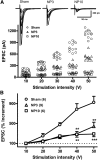

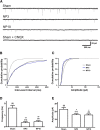
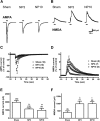
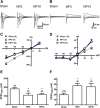
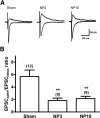
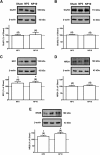
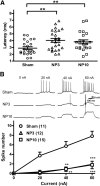
Similar articles
-
Impairment of adenylyl cyclase-mediated glutamatergic synaptic plasticity in the periaqueductal grey in a rat model of neuropathic pain.J Physiol. 2015 Jul 1;593(13):2955-73. doi: 10.1113/JP270384. Epub 2015 May 14. J Physiol. 2015. PMID: 25868084 Free PMC article.
-
Decreased Glutamatergic Synaptic Strength in the Periaqueductal Gray Contributes to Maintenance of Visceral Pain in Male Rats with Experimental Pancreatitis.Neuroscience. 2020 Jan 21;428:60-69. doi: 10.1016/j.neuroscience.2019.12.004. Epub 2019 Dec 27. Neuroscience. 2020. PMID: 31887362
-
Effects of activation of group III metabotropic glutamate receptors on spinal synaptic transmission in a rat model of neuropathic pain.Neuroscience. 2009 Jan 23;158(2):875-84. doi: 10.1016/j.neuroscience.2008.10.042. Epub 2008 Oct 30. Neuroscience. 2009. PMID: 19017536 Free PMC article.
-
Periaqueductal Gray Glutamatergic Transmission Governs Chronic Stress-Induced Depression.Neuropsychopharmacology. 2018 Jan;43(2):302-312. doi: 10.1038/npp.2017.199. Epub 2017 Aug 30. Neuropsychopharmacology. 2018. PMID: 28853438 Free PMC article.
-
Targeting long-term depression of excitatory synaptic transmission for the treatment of neuropathic pain.FEBS J. 2022 Dec;289(23):7334-7342. doi: 10.1111/febs.16200. Epub 2021 Sep 28. FEBS J. 2022. PMID: 34528400 Review.
Cited by
-
Pharmacologically inhibiting GluR2 internalization alleviates neuropathic pain.Neurosci Bull. 2015 Oct;31(5):611-6. doi: 10.1007/s12264-015-1556-2. Epub 2015 Aug 6. Neurosci Bull. 2015. PMID: 26248656 Free PMC article.
-
Neural Plasticity in the Brain during Neuropathic Pain.Biomedicines. 2021 May 31;9(6):624. doi: 10.3390/biomedicines9060624. Biomedicines. 2021. PMID: 34072638 Free PMC article. Review.
-
Neural dysfunction following respiratory viral infection as a cause of chronic cough hypersensitivity.Pulm Pharmacol Ther. 2015 Aug;33:52-6. doi: 10.1016/j.pupt.2015.06.006. Epub 2015 Jun 30. Pulm Pharmacol Ther. 2015. PMID: 26141017 Free PMC article. Review.
-
Chronic Monoarthritis Pain Accelerates the Processes of Cognitive Impairment and Increases the NMDAR Subunits NR2B in CA3 of Hippocampus from 5-month-old Transgenic APP/PS1 Mice.Front Aging Neurosci. 2017 May 12;9:123. doi: 10.3389/fnagi.2017.00123. eCollection 2017. Front Aging Neurosci. 2017. PMID: 28553223 Free PMC article.
-
Impairment of adenylyl cyclase-mediated glutamatergic synaptic plasticity in the periaqueductal grey in a rat model of neuropathic pain.J Physiol. 2015 Jul 1;593(13):2955-73. doi: 10.1113/JP270384. Epub 2015 May 14. J Physiol. 2015. PMID: 25868084 Free PMC article.
References
Publication types
MeSH terms
Substances
LinkOut - more resources
Full Text Sources
Other Literature Sources
Miscellaneous
